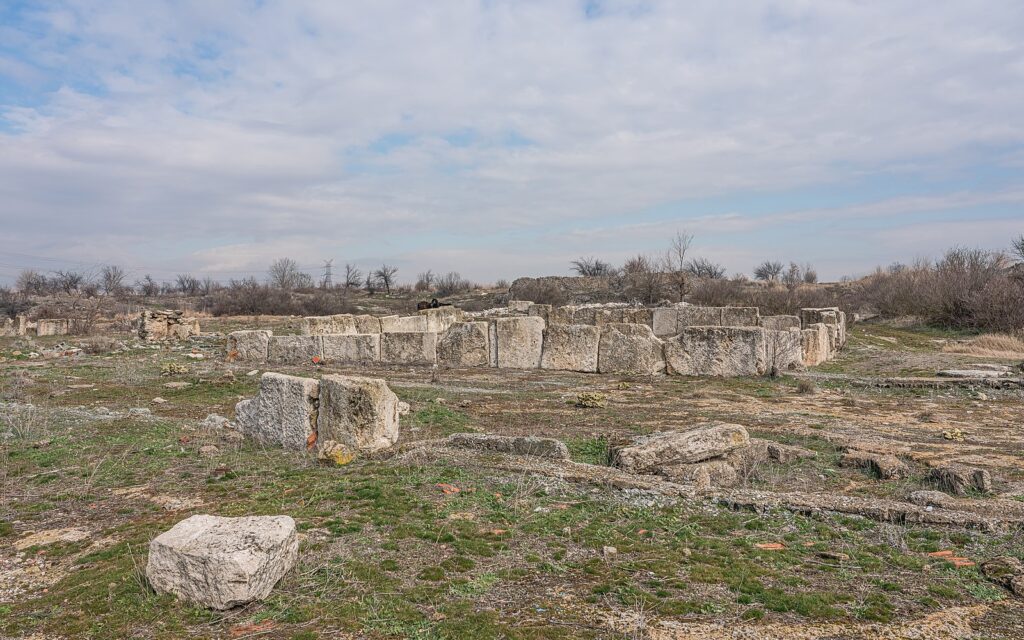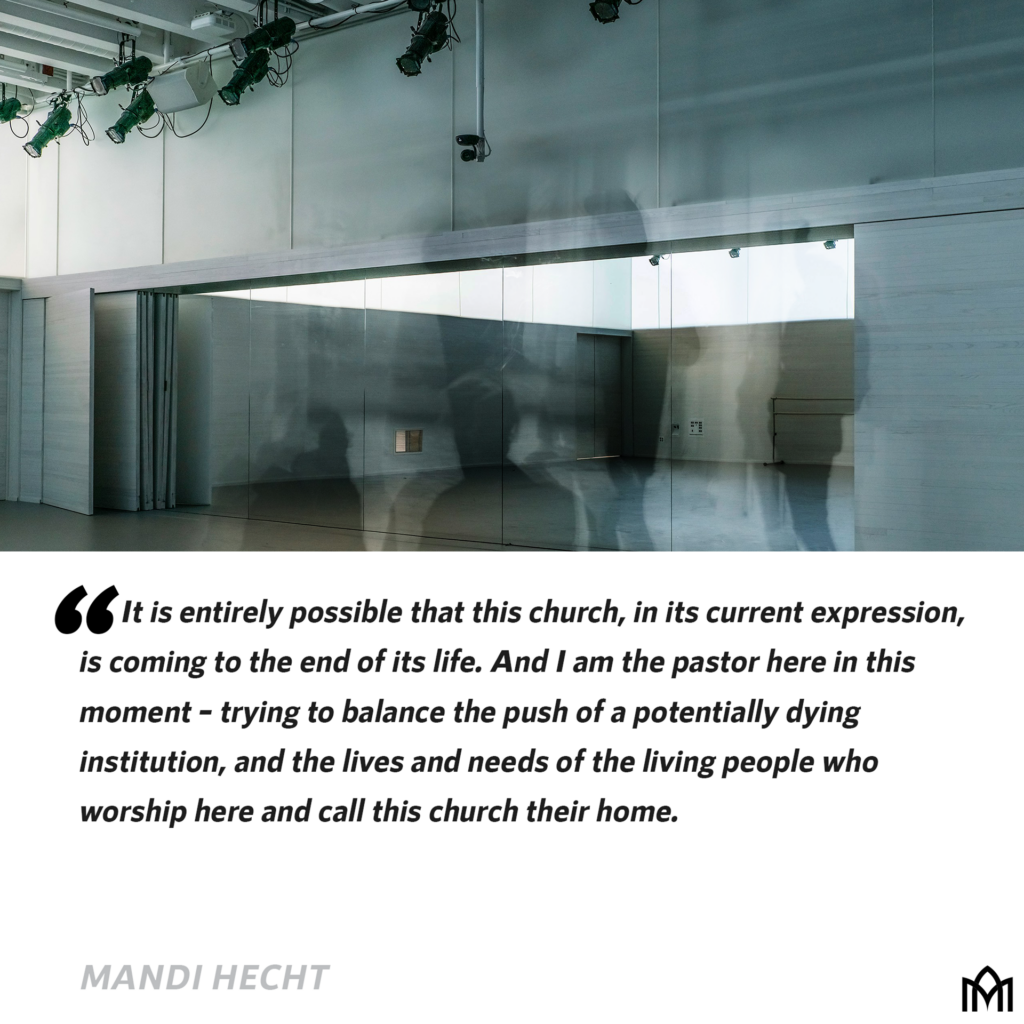Walking Toward Shalom: Hospice Wisdom for a Declining Church
In modern-day Türkiye, there is a yet-to-be excavated site where the ancient city of Colossae1 was located. Somewhere, buried deep under centuries of dirt, there is the ruins of a church. By the Byzantine era, the Church of St. Michael in Colossae was one of the largest churches of its time. Today, the location of this significant church is lost to us.2

By A.Savin – Own work, FAL, https://commons.wikimedia.org/w/index.php?curid=87546204.
Sometimes I worry that the church I pastor might be dying. Even though I would prefer to spin the story or deny the evidence, it is mounting. A once-full sanctuary echoes on a Sunday morning as people are free to space themselves out throughout the pews. There are key leadership positions that remain unfilled. The offering plate is emptier, and donations don’t quite stretch to cover even a pared-down budget. The average attendee is aging, and increasingly tired. There are grave comments made in congregational meetings such as: “How many of us will realistically be here in five years?” We have met, discussed, wrung our hands, and hired. We have even prayed. But the signs of decline persist.
Facing questions about the future is nothing new for this community. This church has been extant for 120 years, and yet there are records of meetings held back in the 1960s when the congregation entertained questions of declining church attendance, lack of leaders to fill important positions, and the viability of supporting an aging building in a downtown neighbourhood. You can’t say that we didn’t give it a good, long try. But it is entirely possible that this church, in its current expression, is coming to the end of its life. And I am the pastor here in this moment – trying to balance the push of a potentially dying institution with the lives and needs of the living people who worship here and call this church their home.
As the evidence mounts, I increasingly cannot escape this chilling thought, even as I struggle to hold out hope:
What if my church is, in fact, palliative?3
Even as we face the potential of institutional death, I hold on to the possibility we could pivot, change focus, plant a seed that will grow and bloom, or even receive a miracle. There are stories of this kind of miracle found in our holy book. The stump of Jesse grows a new shoot (Isaiah 11:1). The Hebrew people were carried off into exile (more than once) and the temple in Jerusalem was razed to the ground (also more than once) – and still they persisted. The apostles and other followers of Jesus watched in horror when Jesus was arrested, hung on a cross, and buried in a tomb. And they marveled when Christ was raised from the dead. This is the beating heart of our faith. I cherish these stories of resurrection, hope in places of hopelessness, new life after certain death. I believe them wholeheartedly. I preach from them regularly.
But that also might not be what is happening in my local church. There is, after all, in modern-day Türkiye, a once-thriving church that is currently sitting under a burial mound in Colossae, waiting to be excavated. And there is no physician or expert who can tell us for certain what the future of this church will be. The work of God will carry on, of that I have no doubt. The ministry of this church might not. As time goes on, the prospect of staving off decline in my local church seems more remote. The diagnosis might be terminal. And it might be time for us to be honest about this.
Sometimes I worry that the church I pastor might be dying. Even though I would prefer to spin the story or deny the evidence, it is mounting. A once-full sanctuary echoes on a Sunday morning as people space themselves out. (1/3) Share on X
You can’t say that we didn’t give it a good, long try. But it is entirely possible that this church, in its current expression, is coming to the end of its life. (2/3) Share on X
I am the pastor here in this moment, trying to balance the push of a potentially dying institution with the lives and needs of the living people who worship here and call this church their home. What if my church is palliative? (3/3) Share on X
Improbably, I found hope for my church community when I made a visit, with a group of other pastors in my city, to a local hospice4 on a cold January morning earlier this year. The couple of hours we spent in this place were some of the warmest and most peaceful that I have spent in recent memory. The employee who toured us through this facility might describe herself as an artist, but her official title is not “art therapist.” This is because, as she told us, when a person enters a hospice, they don’t need more therapy; instead, what they need is “integration.” If she were a theologian she might have reached for the word “shalom.” “Shalom” is a Hebrew word which is typically translated “peace,” but it is a wide-ranging concept which has senses of harmony, wholeness, completeness, prosperity, welfare, abundance, tranquility, and the perfection of God’s creation. One definition that I particularly like, coined by Jodi Spargar, is this:
“Shalom is where no one is missing, and nothing is broken.”5
This hospice exuded “shalom” for me. The residents who enter the doors of this place acknowledge that their death is (in all likelihood) imminent. Even so, harmony and wholeness abounded there. And the peace of this unlikely place gives me hope for my local church, which may be in the process of dying, even if we are not 100% comfortable with admitting it. Perhaps the hospice, and those who have received the diagnosis “palliative,” can lend us their wisdom.
///
Neurosurgeon Paul Kalanithi was 36 years old when he was diagnosed with Stage IV lung cancer, a disease that would ultimately claim his life. As he weighed the acute knowledge of the probability of his death with the truth that he was still alive, Paul wanted to know how long he had to live. Kalanithi was not given a number of days, months, or years; instead, his cancer specialist urged him instead to focus on his values. As he writes in his Pulitzer Prize nominated book, When Breath Becomes Air: “I had to face my mortality and try to understand what made my life worth living.”6
Kalanithi’s experience as a palliative patient ultimately led him to the discovery that “the physician’s duty is not to stave off death or return patients to their old lives, but to take into our arms a patient and family whose lives have disintegrated and work until they can stand back up and face, and make sense of, their own existence.”7 Perhaps the last leader of the church in Colossae would say something similar. Perhaps the job of a pastor or other church leader is not to stave off death forever or return a church to its glory days. Perhaps those who worship in such a community might hear the comfort that the future holds more potential for wholeness than longing for the past. Instead of longing for the past, a church in decline can stand back up to face, and to make sense of, their own existence.
When a person enters a hospice, they don’t need more therapy; instead, what they need is 'integration.' If she were a theologian, the hospice art therapist might have reached for the word 'shalom.' (1/2) Share on X
Shalom is a Hebrew word which is typically translated 'peace,' but it is a wide-ranging concept meaning harmony, wholeness, completeness, prosperity, welfare, abundance, tranquility, and the perfection of God’s creation. (2/2) Share on X
There is a saying which has been variously attributed (to none less than such giants in the Christian faith as Martin Luther and John Wesley) that states, “If the world were to end tomorrow, I would plant an apple tree today.” The time may be short, and we might not know how much of it there is left. But this is precisely when we should begin to decide who we will be tomorrow. There is yet time to make the life of this institution meaningful and good. There is still good to be done, even if we are facing the end of the world or the end of a life. We can still make this place beautiful.8
So, yes, we might have to acknowledge that we should prepare for the death of this local church, and that the people who remain will one day live with the realized grief that the doors are shut, and that they will have to start over again in a new faith community. But if we rightly number our days, this season in the life of the church might allow us to get serious about the business of shalom by taking stock of who is missing and what is broken, and get to work apologizing, fixing, and gathering in worship. The wisdom of the hospice for those who face the possibility of living their faith without the comfort of a community that has formed them is that there is yet hope. We might use the assets and time we still possess to leave a signpost for the future – we were here, we loved each other and Jesus well, and all of it mattered. We can still plant trees, steward our assets, gather the missing, find a way to gaze at the stars, and repeat the stories we love (we are, after all, entrusted with some pretty incredible stories). We can wonder at God’s creation, make some memories, and cultivate deep love – love for God, love for each other, and love for the world.
I am the pastor of this church, and I feel the weight of these days personally and professionally. I don’t want this church to die. But perhaps it is not my job to stave off death. The weight shifts when I think about the beauty that exists in our life together, and the potential that remains even in this declining community. Yes, the fact of death is unsettling. Yes, the grief will roll in when the time comes to finally say “Goodbye.”
But the hope I gained when I visited the hospice is that we can yet strive toward shalom with all the time, however fleeting, that we have left.
///
This season in the life of the church might allow us to get serious about the business of shalom by taking stock of who is missing and what is broken, and get to work apologizing, fixing, and gathering in worship. (1/2) Share on X
Hospice wisdom for those who face the possibility of living their faith without the comfort of a community that has formed them tells us that there is yet hope. We were here, we loved Jesus well, and all of it mattered. (2/2) Share on X
*Editorial Note: Mandi’s incredible piece is the first article in a summer series that we will publish over the next few weeks, introducing our 2024 Writing Fellows Cohort in their own voices. ~CK
Footnotes
1 See https://en.wikipedia.org/wiki/Colossae.
2 Remains of the ancient city of Colossae near Denizli, Türkye. By A.Savin – Own work, FAL, https://commons.wikimedia.org/w/index.php?curid=87546204.
3 Palliative care is specialized medical care for people living with a serious illness, focusing on providing relief from pain and other symptoms of the illness. It is often administered when a patient is deemed to be near the end of their life; however, palliative care can be administered whenever a patient is seriously sick and facing uncertainty in their prognosis, even if they ultimately recover.
4 A hospice is a center which provides palliative care for people whose medical condition is diagnosed as terminal. The hospice that I reference in this piece defines “terminal” as anticipated death occurring anywhere from 24 hours to 12 weeks (three months).
5 I cannot find a place where Jodi has this written this definition down. She uses this phrase while speaking to pastoral colleagues. ~MH
6 Paul Kalanithi, When Breath Becomes Air (New York: Random House, 2016), 142.
7 iBid., 166.
8 With all due credit to Maggie Smith’s poem “Good Bones.”




